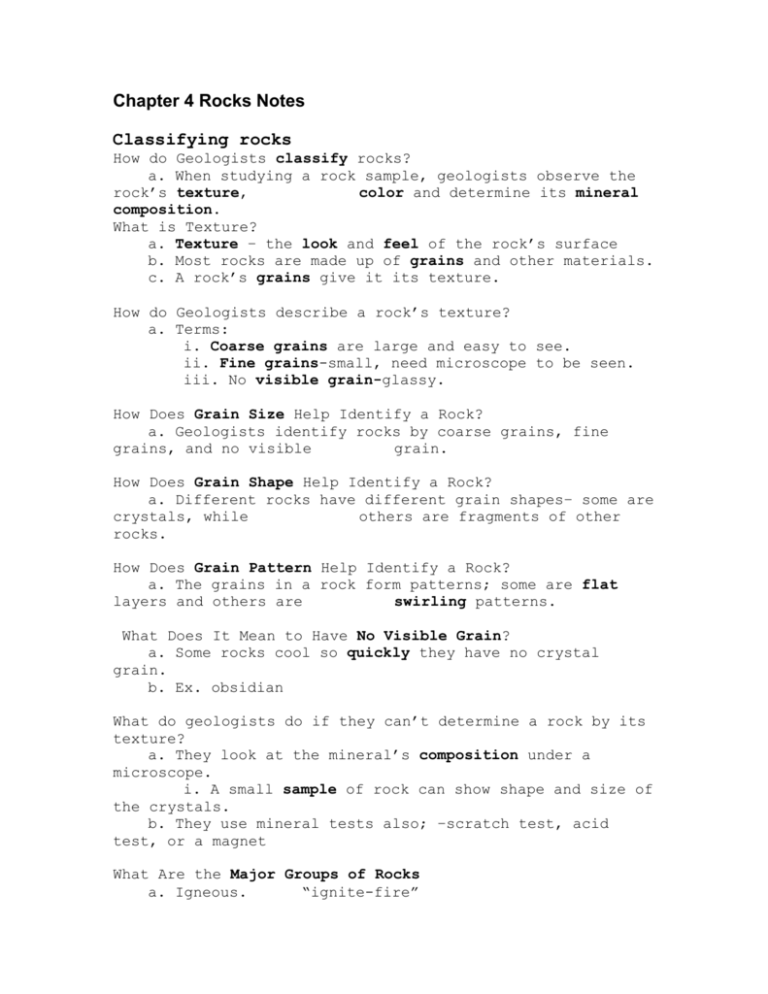Rocks: Classification, Types, and the Rock Cycle
advertisement

Chapter 4 Rocks Notes Classifying rocks How do Geologists classify rocks? a. When studying a rock sample, geologists observe the rock’s texture, color and determine its mineral composition. What is Texture? a. Texture – the look and feel of the rock’s surface b. Most rocks are made up of grains and other materials. c. A rock’s grains give it its texture. How do Geologists describe a rock’s texture? a. Terms: i. Coarse grains are large and easy to see. ii. Fine grains-small, need microscope to be seen. iii. No visible grain-glassy. How Does Grain Size Help Identify a Rock? a. Geologists identify rocks by coarse grains, fine grains, and no visible grain. How Does Grain Shape Help Identify a Rock? a. Different rocks have different grain shapes– some are crystals, while others are fragments of other rocks. How Does Grain Pattern Help Identify a Rock? a. The grains in a rock form patterns; some are flat layers and others are swirling patterns. What Does It Mean to Have No Visible Grain? a. Some rocks cool so quickly they have no crystal grain. b. Ex. obsidian What do geologists do if they can’t determine a rock by its texture? a. They look at the mineral’s composition under a microscope. i. A small sample of rock can show shape and size of the crystals. b. They use mineral tests also; –scratch test, acid test, or a magnet What Are the Major Groups of Rocks a. Igneous. “ignite-fire” b. Sedimentary c. Metamorphic “made up of sediments” “morph, to change” How Are Igneous Rocks Formed? a. Igneous – forms from the eruption of molten rock – either intrusive, below the surface or extrusive at the surface. How Are Sedimentary Rocks Formed? a. Sedimentary – forms when small, solid pieces of other rocks or the remains of plants and animals are pressed and cemented together How Are Metamorphic Rocks Formed? a. Metamorphic – formed when an existing rock is changed by heat or pressure, or chemical reactions b. Most of these rocks are formed underground. Igneous Rocks ● Igneous rocks come from the cooling of melted rock material, called magma. ● Intrusive igneous rocks form when the magma cools slowly under the Earth’s surface. Intrusive igneous rocks have large crystals. ● Extrusive igneous rocks form when the magma cools quickly on the Earth’s surface. Extrusive igneous rocks have very small crystals. Characteristics of Igneous Rocks ● Most igneous rocks are very hard ● Made of crystals ● Layering is not common in igneous rocks Sedimentary Rocks ● Sediment is produced through the process of weathering. Large rocks are broken down very gradually and the smaller pieces are transported by wind, water, and ice. ● Under high temperature and pressure, the sediment becomes compacted (“smashed” together) and cemented (hardened) into sedimentary rock. ● Usually this happens as the sediment is buried more and more deeply under layers of new sediment. Characteristics of Sedimentary Rocks ● Often contain layers ● Look for grains in the rock i. Coarse grain-large crystals ii. Fine grain-small crystals. iii. No grain- glassy Three types of Sedimentary Rock: a. clastic rock- sedimentary rocks that are squeezed together. (ex. shale, sandstone) b. organic rock- remains of plants or animals. (ex. coal) c. chemical rock- minerals that dissolve in solution and crystallize. (ex.-limestone) Metamorphic Rocks ● Sedimentary and igneous rocks can become buried deep in the Earth’s crust. ● Metamorphic rocks form when the buried rock is changed under high temperature and pressure. ● The rock does not melt. New minerals grow and the rock remains solid. Characteristics of Metamorphic Rocks ● Layering is common ● Different layers are made up of different minerals ● Often made of plates and flaky layers Rocks from Reefs What is a Coral Reef? A structure of calcite skeletons built up by coral animals in warm, shallow ocean water Geologists can determine that limestone deposits that began as coral reefs can be found on continents in areas that had warm climates and shallow ocean water. The Rock Cycle ● The rock cycle is the combination of all the processes that act to break down rocks, move sedimentary rocks from place to place, and make new rocks. ● The processes of the rock cycle are very gradual and happens over times that range from thousands to millions of years or longer.




